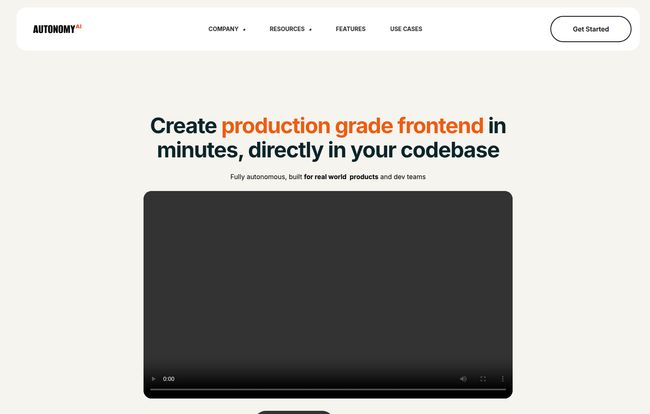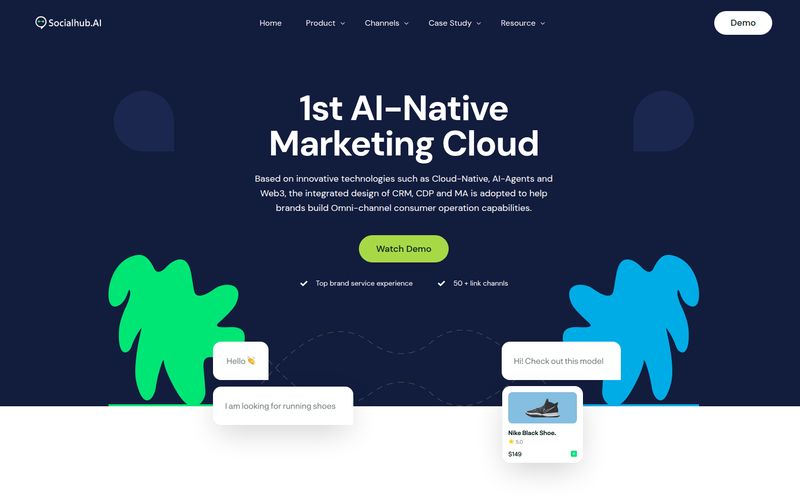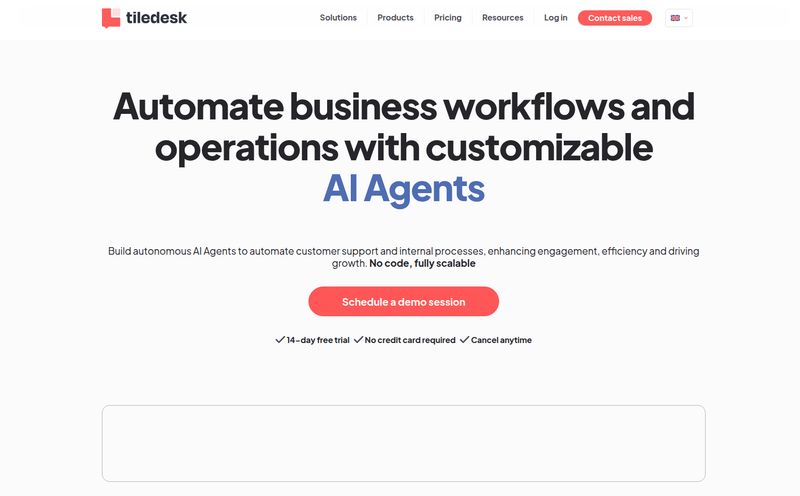I’ve been in the digital trenches for years. I’ve seen trends come and go, from the days of table-based layouts (shudder) to the JavaScript framework-of-the-week frenzy. Through it all, one thing has remained constant: the painful, often tedious gap between a beautiful design and functional, production-ready frontend code.
We’ve all been there. The endless back-and-forth with designers. The soul-crushing boilerplate. The creeping dread of technical debt that starts as a tiny crack and eventually becomes a chasm. So when a tool comes along that doesn't just promise to speed things up, but to act as a whole new teammate, my ears perk up. That’s the promise of Autonomy AI.
And let's be honest, any platform that has a cool wizard mascot has my attention. It’s a nice break from the sterile, corporate branding we usually see. But does a magical mascot translate to magical code? Let's find out.
So What Exactly is Autonomy AI? (It's Not Just Another Copilot)
Okay, first things first. We need to get one thing straight. Autonomy AI isn't another version of GitHub Copilot or a simple autocomplete tool. Those are fantastic assistants, don't get me wrong. I use them. They're like having a seasoned pair programmer whispering suggestions in your ear. Autonomy AI is different. It's more like hiring a brilliant, focused junior developer who you can hand a task to, and they just... go and do it.
This is what the industry is starting to call an AI agent. It doesn't just suggest code; it works autonomously within your existing codebase to build components, iterate on features, and write clean, production-grade code. It’s designed to become an organic part of your team.
The secret sauce seems to be what they call their "Agentic Context Engine (ACE)." It’s a fancy term, but the gist is that this AI actually reads and understands your existing codebase. It learns your design system, your component structure, and your coding style. So, when it generates new code, it’s not just generic React or Vue code—it’s code that looks and feels like it was written by someone who's been on your team for months. This is huge for maintaining consistency and fighting tech debt.

Visit Autonomy AI
The workflow they describe is deceptively simple:
- Drop it in your repo: It connects to your codebase to learn the context.
- Describe your task: You tell it what you need, much like you'd write a ticket for a human developer.
- Get production-ready code: It gets to work and delivers a pull request.
- Learn and improve: It incorporates feedback, learning from every interaction to get even better.
The idea of an AI that can handle a task from a simple description to a finished PR is... well, it’s the dream, isn't it? It frees up senior devs to focus on architecture and complex problem-solving instead of building yet another settings page.
Who Is This Magical Coding Wizard Actually For?
This isn't a one-size-fits-all solution. From what I can gather, Autonomy AI has some very specific teams in mind. I actually appreciate this clarity. Too many tools try to be everything to everyone and end up being great for no one.
The Scrappy Startup Crew
If you're in a startup, you live and die by speed. You need to ship features yesterday. Autonomy AI seems perfect for this environment. It can accelerate development dramatically, helping a small team punch way above its weight. It can even help kickstart a design system from the code you already have, bringing order to the early-stage chaos.
The Established Company and Enterprise Giants
On the other end of the spectrum, you have large organizations. Their problem isn't usually speed, but scale and consistency. With multiple teams working on a single product, maintaining a coherent UI and preventing technical debt is a constant battle. Autonomy AI positions itself as a way to enforce design consistency across the board and help teams safely refactor or reduce that dreaded tech debt. Imagine being able to tell an AI, "Go update all our legacy buttons to the new V2 component," and it just… does it. That's a powerful proposition.
And Who Should Maybe Sit This One Out?
Let's be real. Autonomy AI makes it clear they're not for everyone. If your team is working with a very old, legacy architecture that’s a nightmare to navigate, this AI might struggle. It thrives on structure. It's also not a no-code or low-code platform. You still need developers who understand code to review and merge the AI's work. This is a tool for professional development teams, not a replacement for them.
The Good, The Bad, and The Codebase-Dependent
Every tool has its highs and lows. Here's my breakdown of what gets me excited and what gives me pause.
The Good Stuff (Why I'm Genuinely Excited)
The speed is the obvious win. Turning around frontend components in minutes instead of days is a massive productivity boost. But what really gets my attention is the promise of clean code that respects your existing patterns. This is the holy grail. So many code-generation tools spit out generic junk that you have to spend an hour refactoring. An AI that actually learns your way of doing things could be revolutionary. Reducing technical debt isn't just a line item; it’s a culture shift that leads to happier, more productive developers and a more stable product.
The Reality Check (Let's Be Real)
No tool is a magic wand. The website mentions an initial setup, and we all know that can sometimes be more involved than we'd like. The biggest factor, though, is that its effectiveness is directly tied to the quality of your existing codebase. It's a classic case of "garbage in, garbage out." If your current code is a tangled mess of spaghetti, the AI might have a hard time learning good patterns. It's a tool that rewards teams who have already invested in good architecture. There's also a human learning curve. Your team has to learn how to effectively prompt and work with this new AI teammate, which takes time and patience.
Let's Talk Money... Or Can We? The Pricing Mystery
Alright, this is the part of the review where I usually break down the pricing tiers. So, naturally, I headed over to their pricing page to get you the details, and... oops. I was greeted by a very polite 404 page with a cute, sad robot.
Now, this could mean a few things. Maybe they're in the middle of updating their pricing. Maybe it’s a temporary glitch. Or, more likely, they're focusing on a custom pricing model for enterprise and high-growth teams, where you need to get a quote. This is pretty common for B2B tools in this space. I would guess it's probably a per-seat license, but that's just speculation. For now, the price is a mystery. You'll have to reach out to them directly for a demo and a quote.
Putting it to the Test: My Personal Take
"AutonomyAI is creating a real impact when it comes to managing our R&D. AutonomyAI understands the nuances of our codebase and delivers production-ready code. A truly agentic native developer."
- Vikranth Madam, Sr. Director, R&D, Google Cloud Security
That's a hefty endorsement. I’ve seen a lot of AI coding tools. Most are glorified autocomplete. What intrigues me about Autonomy is that agent concept. The idea that it's a member of the team, taking tickets, creating PRs, and learning from feedback is a significant leap forward. It’s the difference between a tool that helps you write and a tool that does the writing for you.
Their tagline about "Mending the chasm between design and code" really hits home. That chasm is where budgets get blown, deadlines get missed, and developers burn out. If Autonomy AI can truly build a bridge across it, it’s worth its weight in gold.
The Bottom Line: Is Autonomy AI Worth It?
From everything I've seen, Autonomy AI is not a tool for every single team out there. And that's okay. It’s a specialized, powerful force multiplier for professional development teams who are serious about code quality and velocity. If your team already has a decent design system and a relatively modern codebase, this AI agent could legitimately feel like you've hired a new, incredibly fast, and consistent developer.
It’s not here to take your job. It's here to take the most boring parts of your job so you can focus on the fun stuff: solving hard problems and building amazing things.
Frequently Asked Questions about Autonomy AI
- Is Autonomy AI just another version of GitHub Copilot?
- Not at all. Think of Copilot as a pair programmer (an assistant) that suggests code as you type. Autonomy AI is an agent. You give it a task, and it works autonomously to complete that task and submit a pull request, much like a human team member.
- Will Autonomy AI replace my frontend developers?
- No. It's designed to augment developers, not replace them. It handles the repetitive, boilerplate-heavy tasks, freeing up human developers to work on complex logic, system architecture, and user experience challenges. You still need humans to define the tasks and review the code.
- How much setup is actually involved?
- Based on their documentation, the initial setup involves connecting it to your code repository. The real "work" is ensuring your codebase is in good shape with clear patterns and a design system (or the beginnings of one) for the AI to learn from effectively.
- What happens if my codebase is a mess?
- The AI's effectiveness will likely be limited. It learns from your existing code, so if the code is inconsistent or unstructured, the AI won't have good patterns to follow. It performs best in a well-organized environment.
- I can't find the pricing, what gives?
- As of this writing, their pricing page leads to an error. This often indicates a custom pricing model for teams. The best approach is to contact their sales or support team directly through their website to request a demo and a personalized quote.
A Glimpse into the Future of Development
Tools like Autonomy AI represent a fascinating shift in software development. We're moving from simple assistance to true collaboration with our AI counterparts. It’s not about replacing human ingenuity, but amplifying it. By automating the grunt work, we create more space for innovation and creativity. If you're on a frontend team that's looking to move faster without sacrificing quality, Autonomy AI is definitely one to watch. It might just be the new teammate you’ve been looking for.
Reference and Sources
- Autonomy AI Official Website
- Emerging Architectures for LLM Applications (for context on agentic systems)



